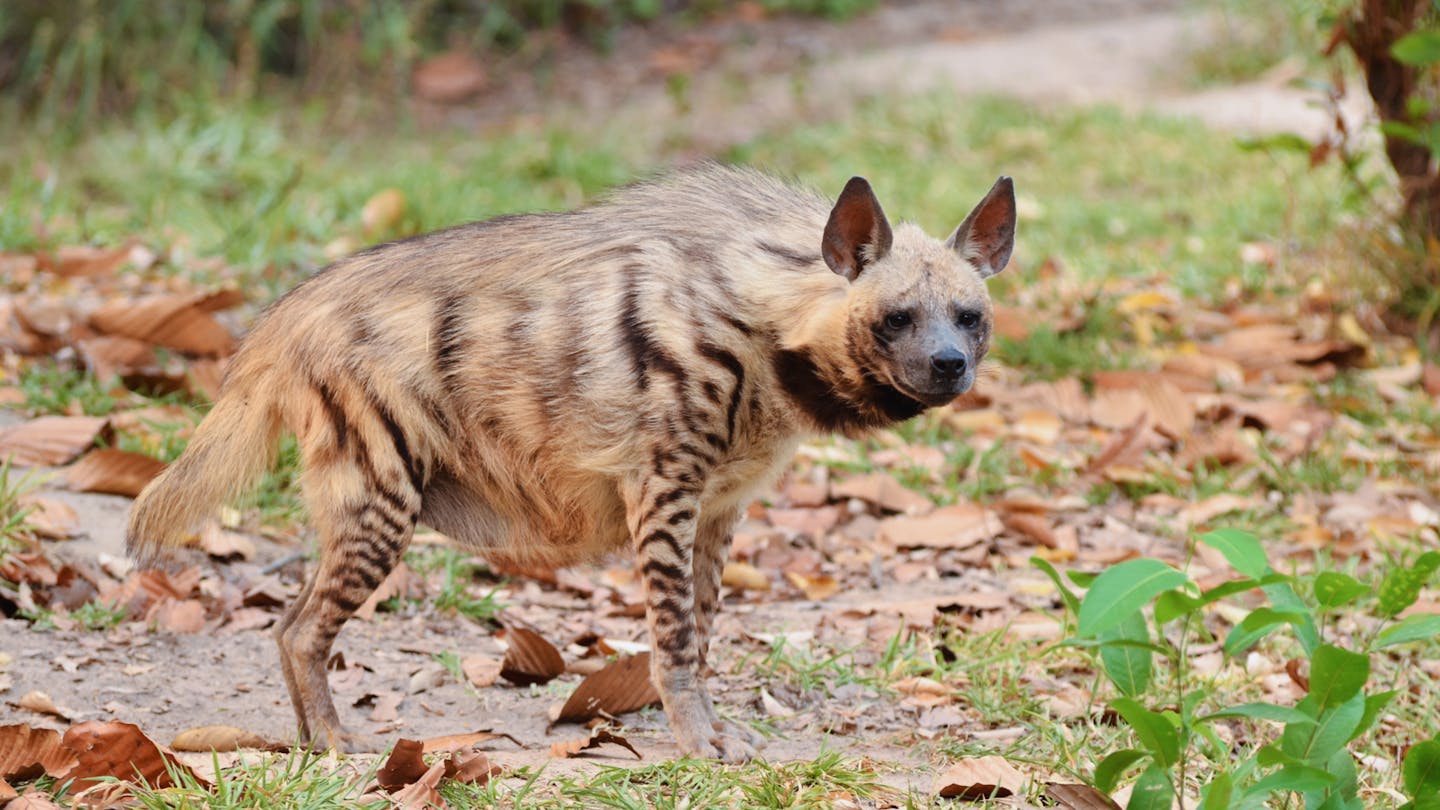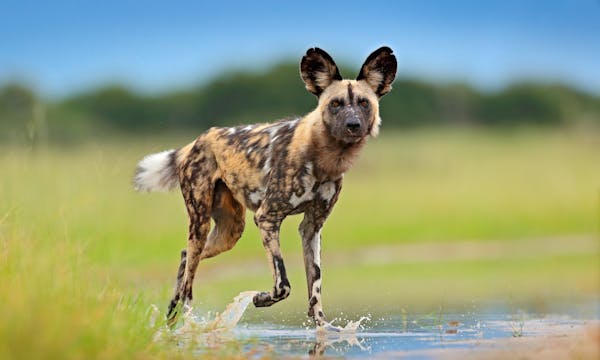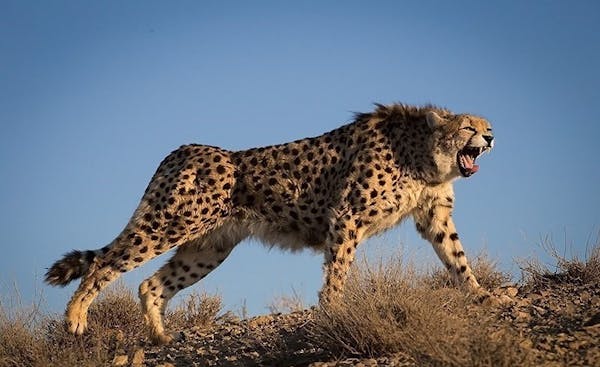Striped hyenas: Perhaps nature’s most misunderstood clean-up crew
- Nature Conservation
- Land Conservation
- Iconic Species
- Wildlife
- Mammals
- Mediterranean
- Western Eurasia Realm
One Earth’s “Species of the Week” series highlights an iconic species that represents the unique biogeography of each of the 185 bioregions of the Earth.
Silent, solitary, and often shrouded in myth, the striped hyena (Hyaena hyaena) is one of the world’s most elusive carnivores. With its haunting vocalizations and ghostly appearance, it has captured the imagination of cultures for millennia, frequently appearing as a creature of fear or folklore.
But behind the superstition lies a shy and yet vital scavenger whose role in the ecosystem is anything but sinister. Native to arid regions across Africa, the Middle East, and South Asia, the striped hyena quietly goes about its nightly business, cleaning up the wild.

Striped hyenas are the iconic species of the Aegean Sea & East Mediterranean Mixed Forests bioregion (PA18), located in the Mediterranean subrealm of Western Eurasia.
Thriving in remote landscapes from Africa to India
Striped hyenas have a broad but fragmented range, stretching from North and East Africa across the Middle East, the Caucasus, Central Asia, and into the Indian subcontinent. They are most commonly found in arid or semi-arid environments, including savannas, open woodlands, rocky hillsides, and desert margins.
Though their distribution is patchy today, populations remain stable in parts of India and East Africa. During the day, they take shelter in caves, dense thickets, or burrows, emerging at night to scavenge and forage.
A distinct appearance and powerful bite
Though the smallest of the hyena species, the striped hyena is still a robust animal. Adults typically weigh around 35 kilograms (77 pounds) and measure up to 130 centimeters (51 inches) in length.
Their long forelegs and shorter hind legs give them a sloping back, while a thick mane running along the spine can be raised during threat displays. Their dense winter coat is grayish, with black stripes on the legs and flanks, helping them blend into moonlit terrain.
Equipped with powerful jaws, their bite is strong enough to crush large bones—including the thigh bones of camels. This strength, combined with large molars and specialized anal scent glands, makes them exceptionally well-adapted to a scavenging lifestyle.
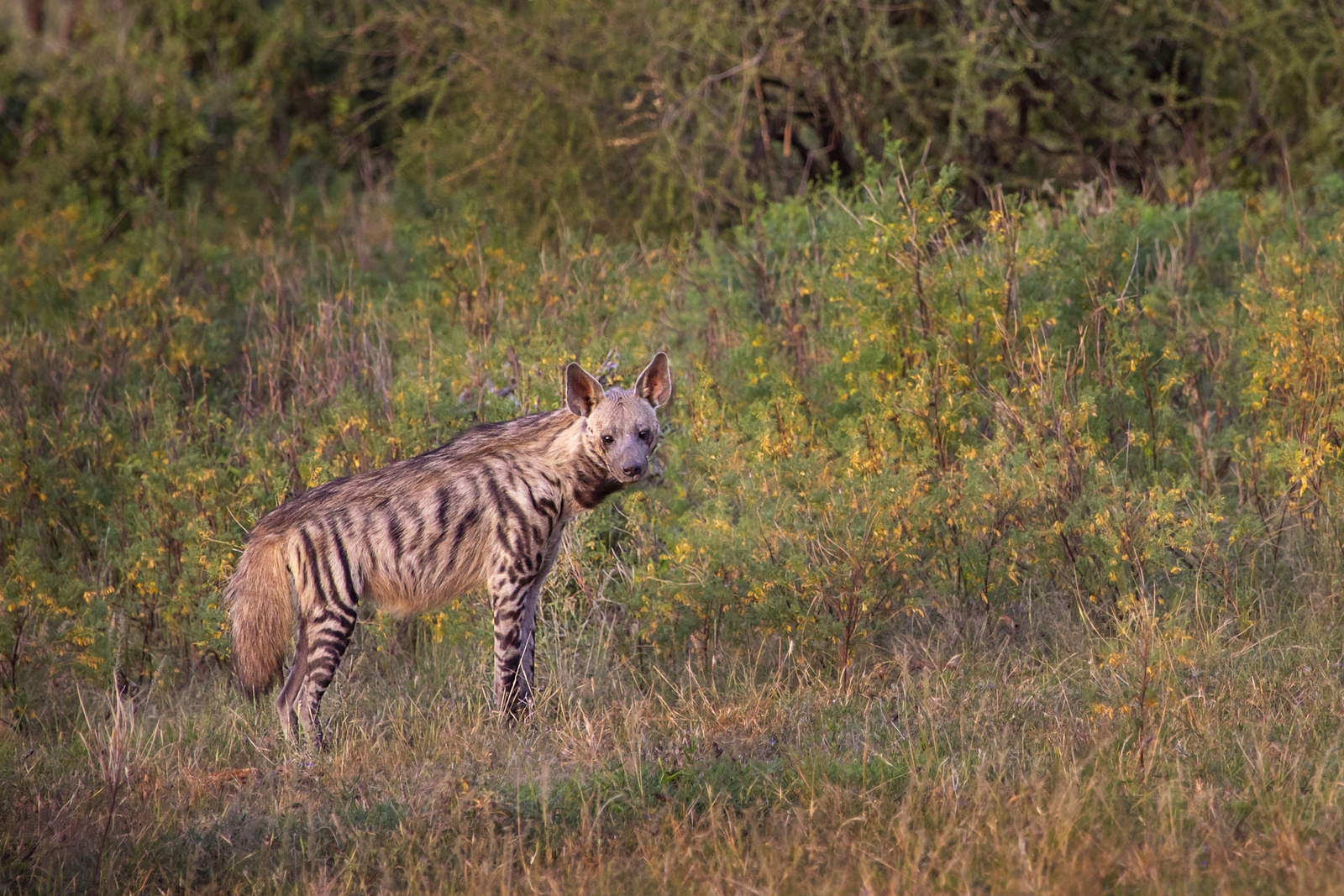
Striped hyena in Samburu, Kenya, Africa. Image credit: © Turfantastik | Dreamstime
A diet built on decay and scavenging
Striped hyenas are primarily scavengers, feeding on carcasses, bones, cartilage, and decaying meat. However, they are not above catching their own prey when the opportunity arises.
In some regions, they hunt porcupines, tortoises, wild boar, and small ungulates. Their diet also includes fruits, insects, and refuse, making them highly adaptable in human-dominated landscapes.
In parts of Jordan and Israel, they regularly scavenge garbage and dead livestock. Unlike their spotted cousins, striped hyenas require more water and will gorge themselves when food is abundant.
Keeping ecosystems clean and disease-free
As nature’s clean-up crew, striped hyenas play a crucial ecological role. By consuming decomposing animals, they help reduce the spread of disease and recycle nutrients back into the environment.
Their bone-crushing abilities allow them to access calcium and marrow that most other scavengers cannot. The white, calcium-rich droppings they leave behind are often visible from afar and serve as a telltale sign of their presence.
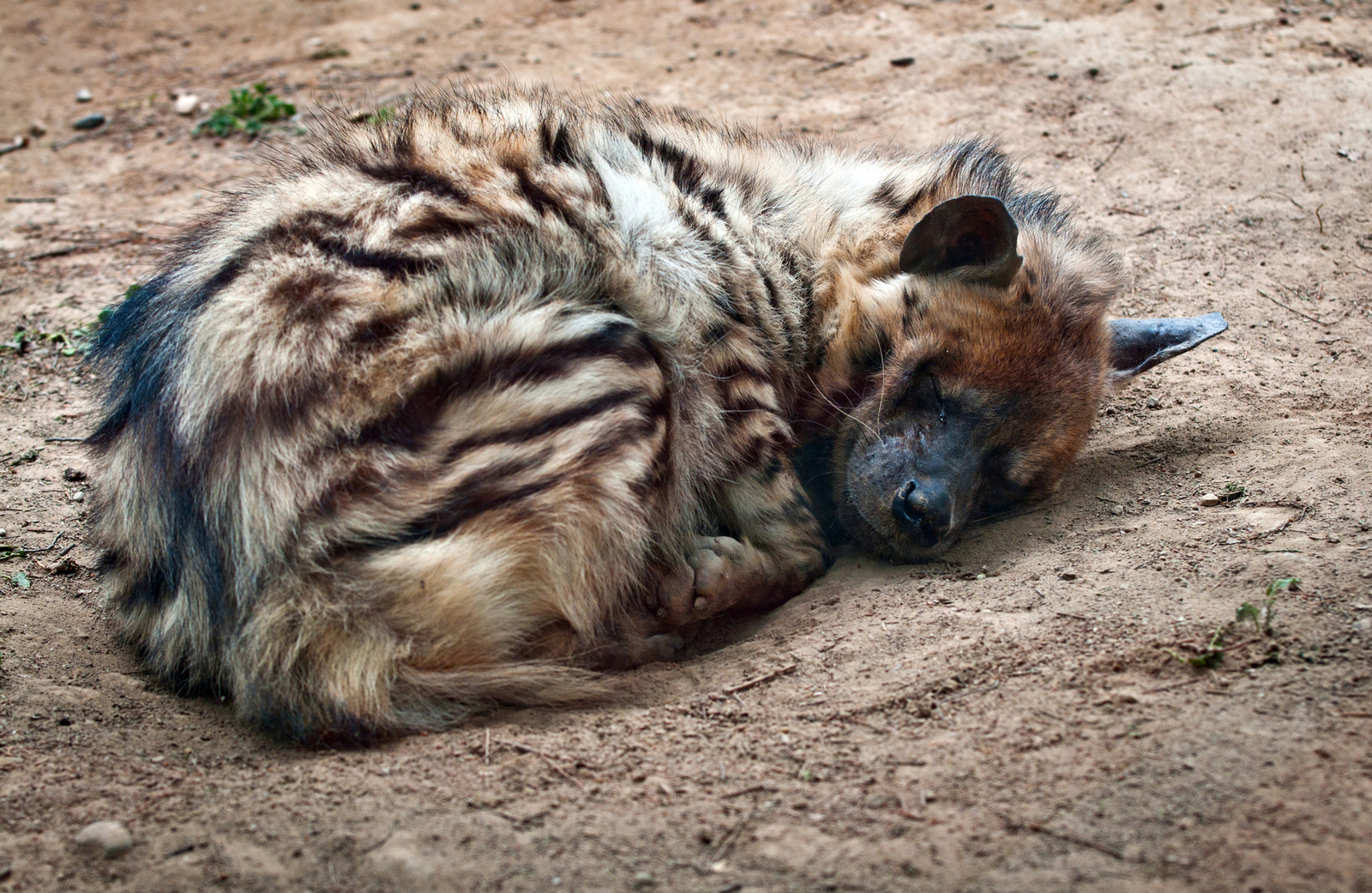
A solitary, sleeping striped hyena. Image credit: © Fotokon | Dreamstime
Solitary lives, secretive behavior, and surprising alliances
Striped hyenas are nocturnal and typically solitary, though pairs and small groups of up to seven individuals have been documented. Unlike the highly social spotted hyena, striped hyenas are monogamous.
Mated pairs raise their cubs together, sharing feeding and protection duties. They communicate through scent marking using their anal glands, raising their mane in displays of aggression, and emitting occasional howling or chattering sounds.
Interestingly, striped hyenas sometimes form surprising alliances. In parts of Central Asia and the Middle East, they have been observed cohabiting with or trailing wolf packs, seemingly benefiting from the wolves' hunting prowess while contributing their own keen sense of smell.
From birth to adulthood in a hidden world
Mating seasons vary by region, and births typically follow a 90-day gestation period. Cubs are born with their eyes closed but already display adult-like stripes. Both parents take part in raising the young, which are weaned at around two months. By autumn, they reach about half the size of their parents. In the wild, striped hyenas can live up to 12 years, and over 20 years in captivity.

A striped hyena, as depicted on the Nile mosaic of Palestrina. Image credit: Wolfgang Rieger, Wiki Commons
A creature of legend and folklore
For thousands of years, this elusive animal has held a place in the mythology, medicine, and daily lives of communities across the Middle East, Central Asia, and parts of Africa. In ancient Persian and Arabic folklore, it was believed to possess mysterious powers, including the ability to hypnotize or paralyze with a glance. These stories reflect both awe and fear, revealing a deep cultural fascination with the animal's nocturnal habits and ghostlike presence.
In Afghanistan and Pakistan, body parts have been used in traditional healing practices, love spells, and protective charms, believed to carry spiritual or symbolic power.
In some regions, striped hyenas have even been tamed and trained like dogs, forming strong bonds with humans. These complex relationships show that, while often misunderstood, this animal has long captured the human imagination.
Misunderstood threats and human conflict
Although primarily scavengers, striped hyenas have occasionally preyed on livestock and, in rare cases, on humans—particularly unattended children. In India, historical accounts document such attacks in rural areas.
More commonly, they are blamed for livestock losses and digging up graves, which often leads to persecution. In many regions, they are trapped, poisoned, or killed out of fear or revenge.
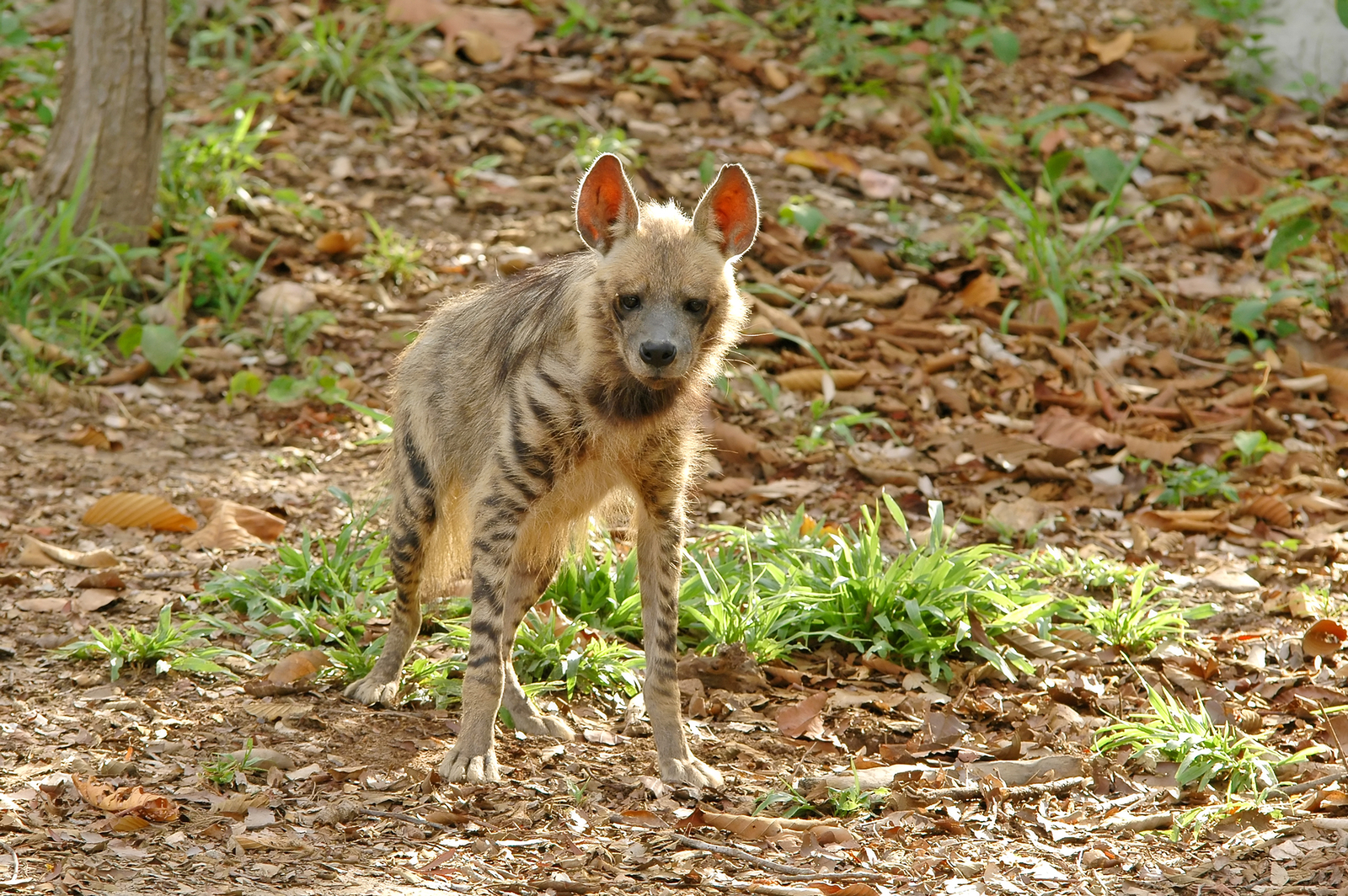
Listed as Near Threatened, striped hyenas faces habitat loss, conflict with humans, and declining prey, yet remains adaptable and resilient. Image credit: © Anankkml | Dreamstime
Conservation challenges and protection efforts
Listed as Near Threatened by the IUCN, the striped hyena faces ongoing threats from habitat loss, human conflict, poisoning, and a declining prey base. Fewer than 10,000 mature individuals remaining globally. Their elusive nature and nocturnal habits make population studies difficult, and conservation efforts are often hindered by cultural stigma.
Nevertheless, protections exist in several countries, including regulations under the Convention on International Trade in Endangered Species of Wild Fauna and Flora (CITES) and initiatives by local wildlife organizations.
In India, striped hyenas benefit from protected areas such as Gir National Park and Velavadar National Park. Continued efforts to raise awareness, reduce human-wildlife conflict, and monitor populations are crucial to their long-term survival.
A role worth recognizing
Though not a stereotypically celebrated icon of the animal kingdom, the striped hyena plays a vital role in maintaining the health of ecosystems. As a quiet cleaner of the wild, it helps preserve balance in environments that support countless other species, including our own.
By learning more and challenging outdated perceptions, we can help rewrite the striped hyena's story—from one of fear to one of respect. Protecting this resilient species means protecting the health of the landscapes we all share.
Support Nature Conservation